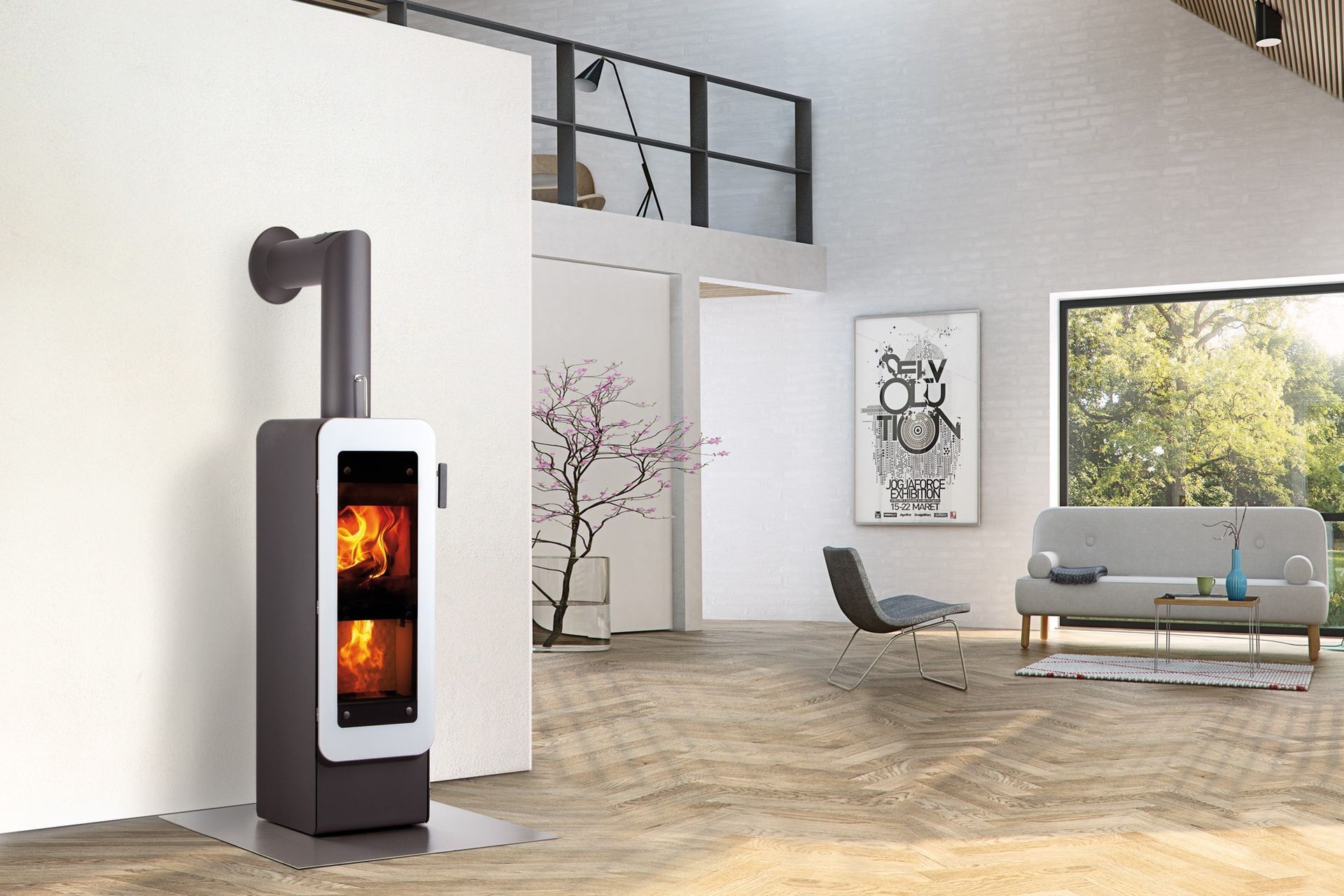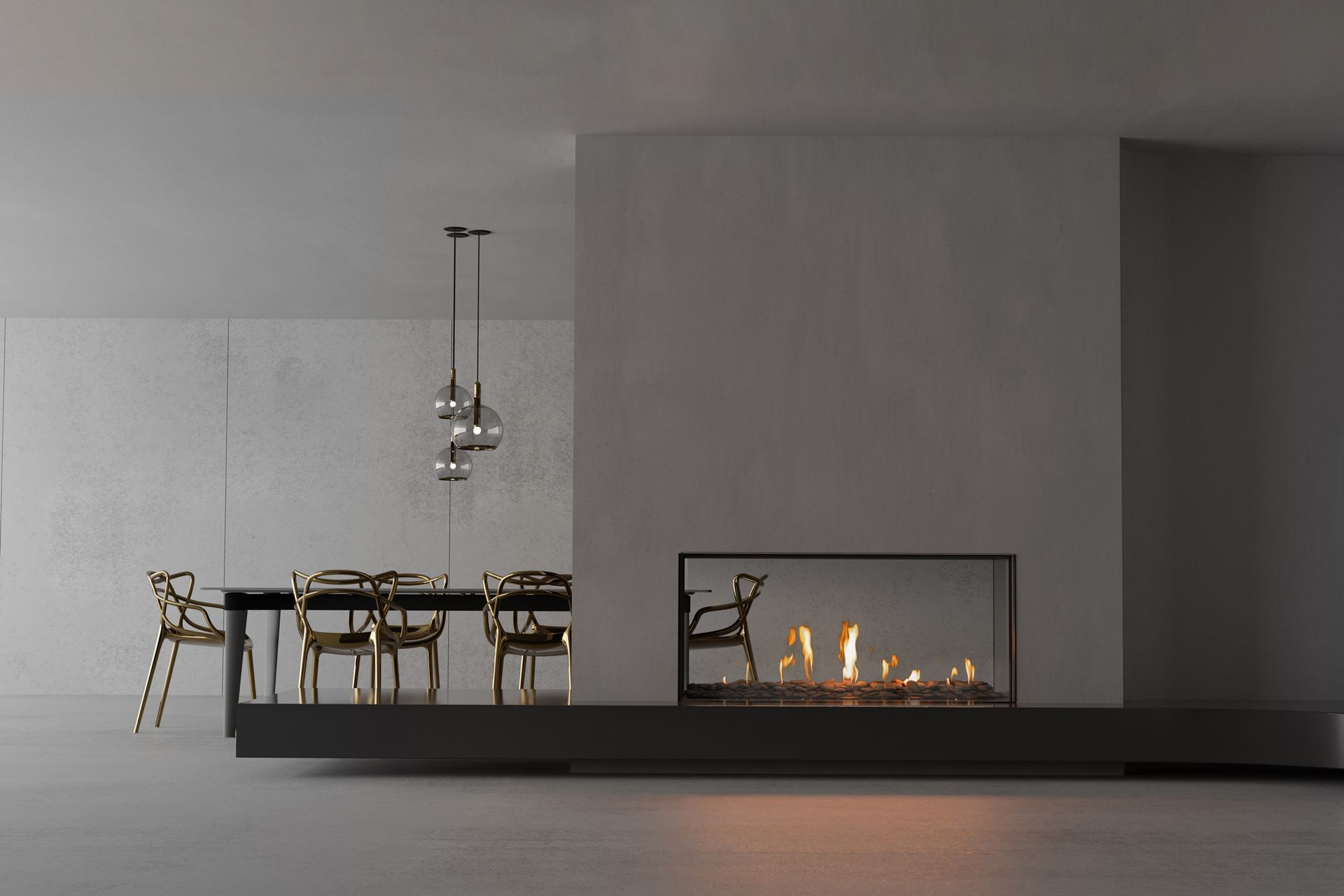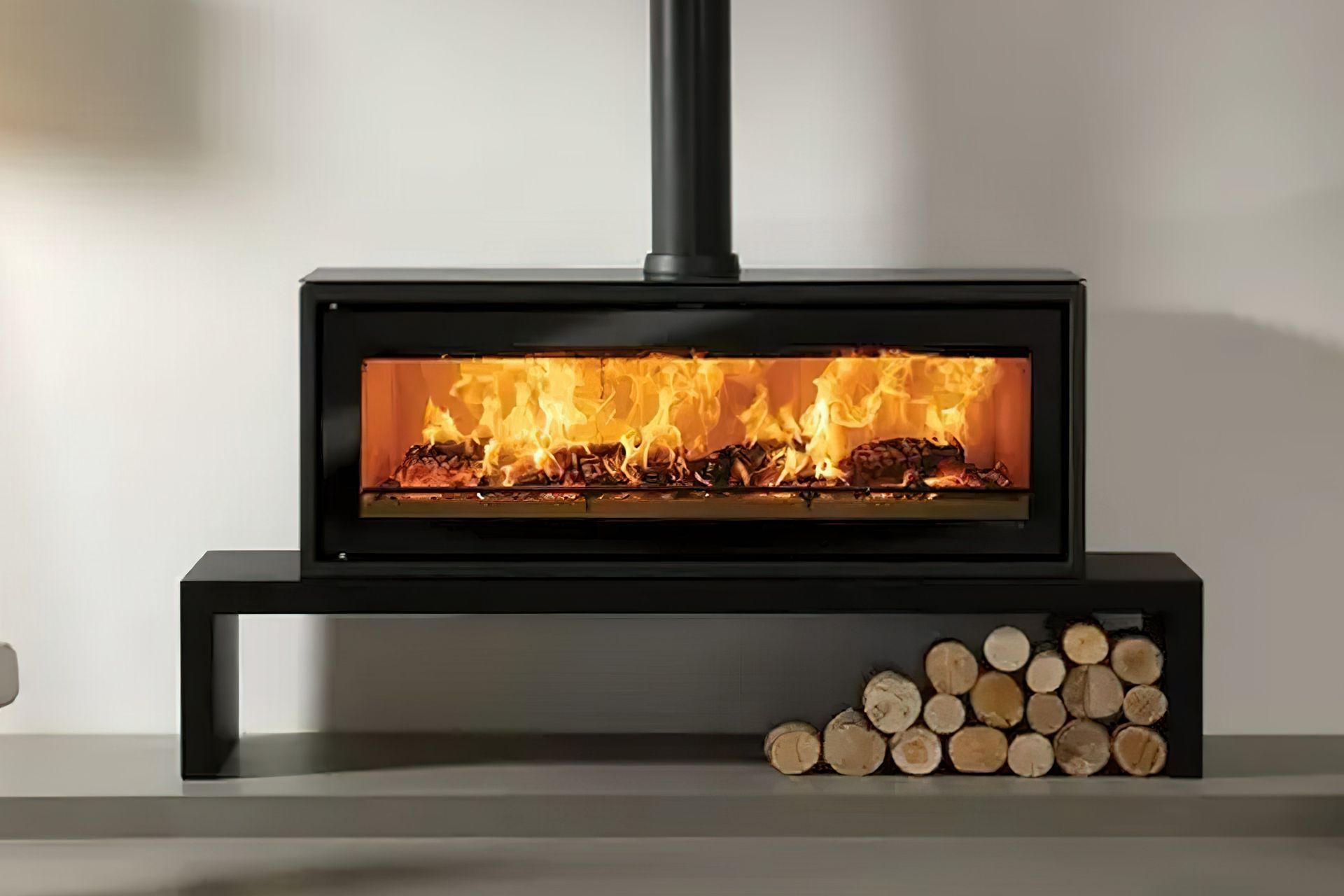The great debate: deciding between a wood-burning or gas fireplace for your home

The invention of the fireplace brought heat into our homes, becoming a cornerstone of domestic life. Over time, technological advancements have resulted in the introduction of different types of fireplaces, with options to suit a variety of needs and preferences. In this comparison, we'll focus on two of the main types of fireplaces, wood-burning and gas, providing an in-depth analysis to help you decide which is best suited to your home.
What is a wood-burning fireplace?
A wood-burning fireplace is a traditional fireplace that burns wood logs or pellets to produce heat and create a crackling fire. Typically, a wood fireplace will include a firebox for burning the wood, a chimney to vent the smoke outside, and a hearth to catch any falling embers. Wood-burning fireplaces are prized for their classic, rustic charm, with crackling flames, glowing embers, and a distinctive aroma, making them a popular choice for those who enjoy a cosy, traditional atmosphere. They also provide reliable warmth during power outages.
Advantages
- Authentic ambience: Provides a classic, rustic experience with the natural sound, smell, and sight of burning wood.
- Heat during power outages: Continues to provide warmth even if the power goes out, offering a reliable heat source.
- Sustainable fuel source: Wood is a renewable resource, and if sourced locally, it can be an eco-friendly option.
Disadvantages
- High maintenance: It requires regular ash cleaning, chimney inspections, and ongoing maintenance to prevent creosote (a substance produced from burning wood) build-up.
- Environmental impact: Burning wood releases smoke, particulates, and carbon emissions, contributing to air pollution.
- Labour-intensive: Involves the manual work of chopping, hauling, and storing wood, as well as starting and tending the fire.
Initial cost
For an entry-level product at around $1,600, you can expect a basic model that does the job, though it may lack advanced features and aesthetic appeal. Most people choose models in the $2,500 to $3,500 range, typically offering a solid fireplace with some additional features, like a steel plate top for cooking, as well as a sleek design. In the $3,500 to $10,000 range, you'll find options that come from more reputable suppliers that use higher-end materials such as cast iron. At the high end, from $10,000 up to $30,000, you'll find top-tier features, premium materials, and designer brands that offer exceptional quality and style.
Pro tip
Consider a wood-burning fireplace with a wetback system to heat your home and water, cutting utility costs efficiently.

What is a gas fireplace?
A gas fireplace is a contemporary heating solution that uses natural gas or propane as fuel to create a controlled, consistent flame. Unlike traditional wood-burning fireplaces, gas fireplaces offer the convenience of instant ignition and easy control over flame intensity and heat output, often through a remote control or wall switch. They are designed to provide warmth and ambience with minimal effort, making them a popular choice for modern homes. Gas fireplaces can be vented through a chimney or direct vent system or can be vent-free, depending on the installation setup and the specific model chosen.
Advantages
- Convenience: It is easy to use with a switch or remote control, offering instant heat without the need for wood or kindling.
- Low maintenance: Produces no ash or soot, requiring minimal cleaning and maintenance.
- Consistent heat: Provides steady, controllable warmth, with the ability to adjust flame height and temperature.
Disadvantages
- Less authentic: Lacks the natural crackling sound, smell, and rustic feel of a wood-burning fire.
- Dependence on gas supply: This requires a continuous gas supply, which can be disrupted and may not be available in all areas.
- Installation requirements: You may need a gas line installation, adding to the initial cost.
Initial cost
Like wood-burning fireplaces, gas fireplaces vary widely in price, with costs influenced by factors such as materials, brand, and additional features. At the lower end, between $1,200 and $3,000, you'll find basic models that may include features like a remote control and flame lighting functions. Mid-range models, costing between $4,000 and $8,000, are the most popular, offering better materials, enhanced aesthetics, electric ignition, and options like stone or crystal flame beds. At the high end, starting at $10,000, you'll find luxurious brands with unique features, such as infrared remote thermostats and tech logs for added visual appeal.
Pro tip
For better efficiency and safety, opt for a direct vent gas fireplace, which vents exhaust outside and uses outdoor air for combustion.

An in-depth comparison
When choosing between a wood-burning and gas fireplace, several factors come into play that could influence your decision. Whether you're seeking a traditional, rustic feel or prioritising efficiency and ease of use, understanding these differences will help you make an informed choice for your home. Your choice will ultimately reflect your lifestyle preferences and the specific needs of your living space.
1. Cleaning and maintenance
Wood-burning: Wood-burning fireplaces require frequent cleaning to remove ashes and soot, as well as regular chimney inspections to prevent creosote build-up, leading to higher maintenance needs.
Gas: Gas fireplaces are much easier to maintain. There are no ashes or soot to clean, and minimal upkeep is required.
Verdict: Gas fireplaces are more convenient and low-maintenance compared to wood-burning fireplaces, which require cleaning and regular chimney inspections.
2. Sustainability
Wood-burning: Wood-burning fireplaces use wood, a renewable resource that can be sustainably sourced through proper forest management, as fuel. However, the burning process releases carbon dioxide, particulate matter, and other pollutants into the atmosphere. While wood is a renewable energy source, the environmental impact can vary depending on how the wood is harvested, processed, and burned. Inefficient burning can also contribute to deforestation and air pollution.
Gas: Gas fireplaces burn natural gas or propane, both of which are fossil fuels. While they produce fewer particulates and less carbon dioxide than wood-burning fireplaces, they still contribute to greenhouse gas emissions. However, gas fireplaces are typically more efficient, converting a higher percentage of fuel into usable heat, which can reduce overall energy consumption. Despite being a cleaner option than wood, gas is non-renewable, and its extraction and use have broader environmental impacts.
Verdict: Draw. While gas fireplaces are generally more efficient, wood-burning fireplaces offer the potential for renewable fuel if managed properly.
3. Ambience
Wood-burning: Wood-burning fireplaces provide an authentic and traditional atmosphere with crackling sounds, flickering flames, and a distinctive aroma, creating a cosy and inviting environment.
Gas: Gas fireplaces can mimic the appearance of a wood fire but lack the natural sounds and scent of burning wood.
Verdict: Wood-burning fireplaces create a traditional, cosy atmosphere that gas fireplaces can only partially replicate.
4. Safety
Wood-burning: Wood-burning fireplaces can pose several safety risks. The open flames can produce sparks and embers that may escape the fireplace, potentially igniting nearby flammable materials. Creosote build-up in the chimney is another hazard, as it can lead to chimney fires if not cleaned regularly. Additionally, the smoke and particulate matter produced can negatively impact indoor air quality, and the handling of firewood has the risk of physical injury.
Gas: Gas fireplaces are generally safer than wood-burning ones. The flames are controlled and often enclosed behind glass, reducing the risk of burns and fire hazards. Gas fireplaces produce fewer emissions, improving indoor air quality. They also come with safety features like automatic shut-off systems, which activate in case of a malfunction, and eliminate the need for handling firewood, reducing the chance of related injuries.
Verdict: Gas fireplaces are the safer option, with fewer hazards and better control features.
5. Convenience and usability
Wood-burning: Wood-burning fireplaces require more effort and time to use. You must gather, chop, or purchase firewood, manually start the fire, and continuously tend to it to maintain the flames. After each use, you must also clean up ashes and soot. The overall process, from preparation to clean-up, can be labour-intensive and time-consuming.
Gas: Gas fireplaces are highly convenient and easy to use. With just the push of a button or flip of a switch, you can start a fire instantly. There’s no need to handle firewood or deal with messy ashes. Many gas fireplaces also come with remote controls or programmable thermostats, allowing you to adjust the temperature and flame height with ease.
Verdict: Gas fireplaces are far more convenient and user-friendly, making them the clear choice for ease of use.

Cost of running your fireplace
Wood burning
Assuming you use your fireplace most evenings, about five to six nights a week, you’ll need roughly ten cubic metres of firewood for the Winter. This amount drops to around four cubic metres if you use the fireplace only two to three nights a week. The actual amount can vary depending on your location in New Zealand, with colder regions requiring more firewood. Ultimately, the average of this results in a mix of firewood that costs $120 to $150 (excluding delivery), per cubic metre.
Gas
Gas heaters are among the cheapest heat sources, second only to heat pumps. The operating cost of running a gas fireplace in New Zealand will vary from region to region as they have different pricing structures. Regardless, you can expect to pay around 10 to 16 cents per kilowatt hour to run your gas fireplace. There are differing factors that can fluctuate the price such as tariffs and the type of gas used, natural or LPG.

Installation requirements
When installing a new fireplace in New Zealand you may need to acquire a building consent. Furthermore, the application for solid fuel heating (like wood-burning fireplaces) can have its own fees from between $300 to over $500 depending on where you live, the building and the project. The specific rules and requirements can also vary between wood-burning and gas-fuelled fireplaces:
Wood-burning fireplaces
Installation requirements:
- Must be installed according to strict fire safety standards to prevent fire hazards.
- Requires proper clearance from combustible materials, such as walls, floors, and furniture.
- A chimney or flue system must be correctly installed and regularly maintained to ensure the safe venting of smoke and gases.
Building consent:
- Typically required due to the significant fire risk associated with wood-burning fireplaces.
- Consent may be needed for both the fireplace and the chimney or flue system.
- Structural changes to accommodate the fireplace, such as reinforcing the floor or cutting through walls or ceilings, usually require approval.
Environmental compliance:
- Many regions such as the Otago Regional Council Area, have strict emissions standards for wood-burning fireplaces to reduce air pollution.
- In some areas, like the Auckland Regional Council area, the use of wood-burning fireplaces may be restricted or banned during certain times of the year due to air quality concerns.
- You may be required to use an approved model that meets specific environmental standards.
Gas fireplaces:
Installation requirements:
- Must be installed by a qualified and licensed professional.
- Venting and flue systems must meet specific safety standards to ensure proper ventilation of combustion gases.
- The fireplace must comply with the manufacturer’s installation guidelines and local building codes.
Building consent:
- This is required if the installation involves structural changes to the property, such as creating openings for venting. However, since gas fires are certified by gas fitters, the council typically does not need to be involved, and therefore, no building consent is otherwise required for a gas fireplace.
- Some areas may require a specific gas safety inspection before and after installation.

How to choose your fireplace — checklist
1. Heat output and efficiency: Decide if you prefer higher heat output (wood-burning) or higher efficiency and controllable heat (gas).
2. Aesthetics and ambience: Choose traditional charm and natural flames (wood-burning) or clean, modern convenience (gas).
3. Convenience: Consider manual effort and wood management (wood-burning) versus easy operation with minimal maintenance (gas).
4. Environmental impact: Evaluate if you want the renewable but pollutant wood option (wood-burning) or cleaner but fossil fuel-dependent gas (gas).
5. Cost: Compare the installation and ongoing costs of wood (wood-burning) with the installation and running costs of gas (gas).
6. Safety: Assess the higher fire risk and maintenance of wood (wood-burning) versus the generally safer, enclosed gas option (gas).
7. Installation and home structure: Check if your home can accommodate the chimney or flue requirements of wood (wood-burning) or the flexible placement of gas (gas).
What’s your ideal fireplace, wood-burning or gas?
When deciding between a wood-burning and gas fireplace for your home in New Zealand, consider what matters most to you. Wood-burning fireplaces offer a traditional, rustic charm with the natural crackle of wood and a cosy, inviting atmosphere, perfect for those who enjoy the hands-on experience of tending a real fire. In contrast, gas fireplaces provide modern convenience, delivering consistent heat with minimal maintenance at the push of a button. Your choice should reflect your lifestyle, the climate of your region, and your preferences for maintenance and environmental impact, ensuring warmth and comfort for those chilly New Zealand evenings.
Related article: How to choose a fireplace: 8 top tips to get you started
